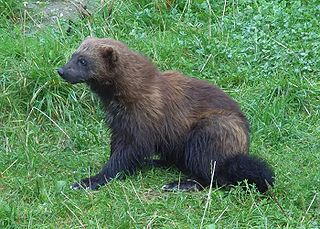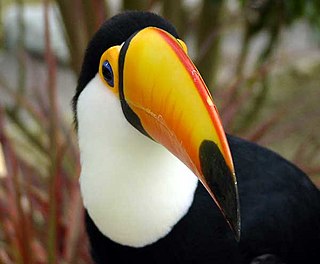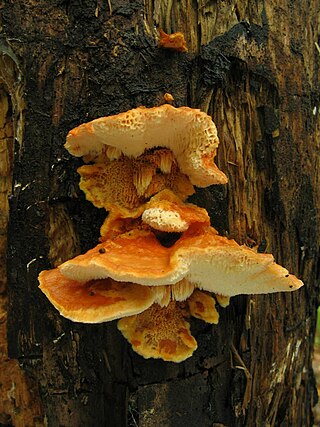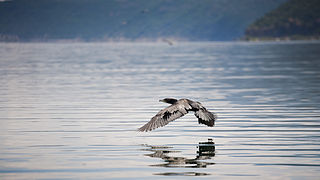
The wolverine, also referred to as the glutton, carcajou, or quickhatch, is the largest land-dwelling member of the family Mustelidae. It is a muscular carnivore and a solitary animal. The wolverine has a reputation for ferocity and strength out of proportion to its size, with the documented ability to kill prey many times larger than itself.

The ringed seal is an earless seal inhabiting the Arctic and sub-Arctic regions. The ringed seal is a relatively small seal, rarely greater than 1.5 m in length, with a distinctive patterning of dark spots surrounded by light gray rings, hence its common name. It is the most abundant and wide-ranging ice seal in the Northern Hemisphere, ranging throughout the Arctic Ocean, into the Bering Sea and Okhotsk Sea as far south as the northern coast of Japan in the Pacific and throughout the North Atlantic coasts of Greenland and Scandinavia as far south as Newfoundland, and including two freshwater subspecies in northern Europe. Ringed seals are one of the primary prey of polar bears and killer whales, and have long been a component of the diet of indigenous people of the Arctic.

Polypores are a group of fungi that form large fruiting bodies with pores or tubes on the underside. They are a morphological group of basidiomycetes-like gilled mushrooms and hydnoid fungi, and not all polypores are closely related to each other. Polypores are also called bracket fungi or shelf fungi, and they characteristically produce woody, shelf- or bracket-shaped or occasionally circular fruiting bodies that are called conks.

The northern flying squirrel is one of three species of the genus Glaucomys, the only flying squirrels found in North America. They are found in coniferous and mixed coniferous forests across much of Canada, from Alaska to Nova Scotia, and south to the mountains of North Carolina and west to Utah in the United States. They are light brown with pale underparts and grow to a length of 25 to 37 cm. They are proficient gliders but uncoordinated walkers on the ground. They feed on a variety of plant material as well as tree sap, fungi, insects, carrion, bird eggs and nestlings. They mostly breed once a year in a cavity lined with lichen or other soft material. Except when they have young, they change nests frequently, and in winter a number of individuals may huddle together in a shared nest. Unlike most members of their family, flying squirrels are strictly nocturnal.

The Holarctic realm is a biogeographic realm that comprises the majority of habitats found throughout the continents in the Northern Hemisphere. It corresponds to the floristic Boreal Kingdom. It includes both the Nearctic zoogeographical region, and Alfred Wallace's Palearctic zoogeographical region.

The Saimaa ringed seal is a subspecies and glacial relict of ringed seal. They are among the most endangered seals in the world, having a total population of only about 400 individuals. The only existing population of these seals is found in Lake Saimaa, Finland. They have lived in complete isolation from other ringed seal species for around 9,500 years and have diverged into a morphologically and ecologically different subspecies of ringed seal. The population is descended from ringed seals that were separated from the rest when the land rose after the last ice age. This seal, along with the Ladoga seal and the Baikal seal, is one of the few living freshwater seals.

In forest ecology, a snag refers to a standing dead or dying tree, often missing a top or most of the smaller branches. In freshwater ecology it refers to trees, branches, and other pieces of naturally occurring wood found sunken in rivers and streams; it is also known as coarse woody debris. Snags provide habitat for a wide variety of wildlife but pose hazards to river navigation. When used in manufacturing, especially in Scandinavia, they are often called dead wood and in Finland, kelo wood.

The long-nosed potoroo is a small, hopping mammal native to forests and shrubland of southeastern Australia and Tasmania. A member of the potoroo and bettong family (Potoroidae), it lives alone and digs at night for fungi, roots, or small insects. It is also a marsupial and carries its young in a pouch. The long-nosed potoroo is threatened by habitat loss and introduced species such as cats or foxes. There are two subspecies: P. t. tridactylus on mainland Australia, and P. t. apicalis on Tasmania, with lighter fur.

The wildlife of Brazil comprises all naturally occurring animals, plants, and fungi in the South American country. Home to 60% of the Amazon Rainforest, which accounts for approximately one-tenth of all species in the world, Brazil is considered to have the greatest biodiversity of any country on the planet. It has the most known species of plants (60,000), freshwater fish (3,000), amphibians (1,188), snakes (430), insects (90,000) and mammals (775) It also ranks third on the list of countries with the most bird species (1,971) and the third with the most reptile species (848). The number of fungal species is unknown. Approximately two-thirds of all species worldwide are found in tropical areas, often coinciding with developing countries such as Brazil. Brazil is second only to Indonesia as the country with the most endemic species.

Fungivory or mycophagy is the process of organisms consuming fungi. Many different organisms have been recorded to gain their energy from consuming fungi, including birds, mammals, insects, plants, amoebas, gastropods, nematodes, bacteria and other fungi. Some of these, which only eat fungi, are called fungivores whereas others eat fungi as only part of their diet, being omnivores.

The wildlife of Canada or biodiversity of Canada consist of over 80,000 classified species, and an equal number thought yet to be recognized. Known fauna and flora have been identified from five kingdoms: protozoa represent approximately 1% of recorded species; chromist ; fungis ; plants ; and animals. Insects account for nearly 70 percent of documented animal species in Canada. More than 300 species are found exclusively in Canada.

Haller Park is a nature park in Bamburi, Mombasa, on the Kenyan coast. It is the transformation of a quarry wasteland into an ecological area. Haller Park holds a variety of plant and animal species which serve as a recreation spot for tourists and locals. Up to March 2007 it held the attraction of Owen and Mzee – the friendship of a hippopotamus and a tortoise.
In biogeography and paleontology, a relict is a population or taxon of organisms that was more widespread or more diverse in the past. A relictual population is a population currently inhabiting a restricted area whose range was far wider during a previous geologic epoch. Similarly, a relictual taxon is a taxon which is the sole surviving representative of a formerly diverse group.

The wildlife of Ukraine consists of its diverse fauna, flora and funga. The reported fauna consists of 45,000 species when including the areas of the Black Sea and the Sea of Azov. Ukraine's protected environments consist of 33 Ramsar sites covering an area of 7,446.51 square kilometres (2,875.11 sq mi). Biosphere nature reserves and three national parks are all part of the GEF projects portfolio of conservation of biodiversity in the Danube Delta. Their vegetation pattern is mixed forest area, forest-steppe area, steppe area, Ukrainian Carpathian Mountains and Crimean Mountains. Some of the protected areas that were reserves or parks are subsumed under the biosphere reserves.

Hällingsåfallet is a waterfall and a nature reserve in Jämtland County in Sweden. It is part of the European Union-wide Natura 2000 network.

In Finland, Kotiranta and Niemelä introduced a widely used method for comparing the conservation values of different forest areas, based on the observation that certain wood-rotting fungi are very sensitive to the impact of human activities on forest ecosystems. Such species are slow to return to areas from where they have disappeared, so their presence is evidence of a long continuity in forest ecosystems.

The Canadian Arctic tundra is a biogeographic designation for Northern Canada's terrain generally lying north of the tree line or boreal forest, that corresponds with the Scandinavian Alpine tundra to the east and the Siberian Arctic tundra to the west inside the circumpolar tundra belt of the Northern Hemisphere.
Located in the Scandinavian Peninsula, Sweden is a mountainous country dominated by lakes and forests. Its habitats include mountain heath, montane forests, tundra, taiga, beech forests, rivers, lakes, bogs, brackish, marine coasts, and cultivated land. The climate of Sweden is mild for a country at this latitude, largely owing to the significant maritime influence.

Over 22,500 species of wildlife have been recorded in North Macedonia. Over 10,000 of these are insects, which include 3,000 beetle species and large numbers of Lepidoptera, flies, and Hymenoptera. Aside from insects, other large arthropod groups include Chelicerata and crustaceans. Among vertebrates, more than 300 species of birds recorded, although not all nest in the country. There are over 80 species of both fish and mammals, 32 reptiles, and 14 amphibians.

Dabas parks Piejūra is a nature park along the Gulf of Riga in Latvia founded in 1962. It is a protected nature reserve and a Natura 2000 location. The park stretches 36.6 kilometres (22.7 mi) over an 4,180 hectares area from Riga, through Carnikava Municipality, and up to Saulkrasti. It is a popular seasonal recreation location, notably for beach access. The park is notable for its protected biotopes, particularly its dunes and boreal forests. The park's conservation plan for 2020 onwards was developed under the "LIFE CoHaBit" project.






















